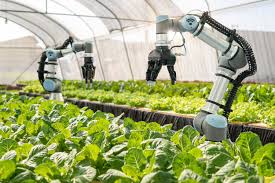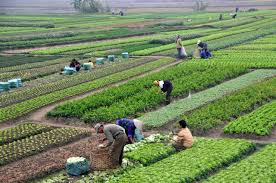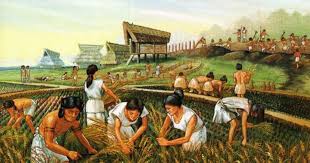The Neolithic Revolution marked a fundamental shift in human history, transitioning from a lifestyle of hunting and gathering to one of agriculture and settlement.
This transformation laid the foundation for modern civilizations, influencing food production, social structures, and technological advancements.
The changes during this period created the basis for economic systems, urbanization, and the complex societies that followed.
Origins of the Neolithic Revolution
The Neolithic Revolution began around 10,000 BCE in different regions, particularly in the Fertile Crescent (modern-day Middle East). It was driven by the domestication of plants and animals, leading to a more stable food supply.
Early humans discovered that certain plants could be cultivated and animals tamed, providing a more reliable source of food compared to the uncertainties of hunting and gathering. This pivotal development allowed communities to settle in one place rather than constantly moving in search of food.
Agricultural Advancements and Food Production

1. Domestication of Crops and Livestock: Early humans began selecting plants with desirable traits, such as larger seeds or sweeter fruit, for cultivation. Wheat, barley, and rice were among the first domesticated crops. Similarly, animals like goats, sheep, and cattle were domesticated for their meat, milk, and hides.
2. Irrigation and Farming Techniques: As agricultural practices evolved, early farmers developed irrigation systems to manage water resources, allowing crops to be grown in areas with less rainfall. Techniques like plowing and crop rotation improved the efficiency of farming, leading to increased food production.
3. Surplus and Food Storage: The ability to produce surplus food allowed communities to store food for future use, which reduced the risks of famine and supported larger populations. This surplus also enabled trade and economic growth within and between communities.
Settlement Patterns and Urbanization
As agriculture became more reliable, people began settling in permanent locations. The development of farming villages eventually led to the rise of towns and cities.
1. Permanent Settlements: With a steady food supply, early humans no longer needed to move constantly, leading to the establishment of permanent homes and communities. These early settlements were typically located near water sources and fertile land.
2. Urban Growth: As populations grew, small farming communities expanded into larger urban centers. These urban centers became hubs for trade, culture, and governance, furthering the development of complex societies. The growth of cities like Jericho and Çatalhöyük during the Neolithic period exemplifies this trend.
3. Social Hierarchies: As settlements grew, so did the need for organization and leadership. This gave rise to social hierarchies, with leaders and ruling classes overseeing resource distribution, law enforcement, and religious practices.
Read Also: Goat Milk Production Complete Guide
Social Structure and Specialization of Labor

The surplus of food created by agricultural advancements allowed people to pursue activities other than farming, leading to specialization of labor and more complex societal roles.
1. Division of Labor: Not everyone was required to be involved in food production anymore. Some individuals took on specialized roles, such as toolmakers, builders, and traders. This division of labor increased efficiency and led to technological and cultural advancements.
2. Social Classes: The rise of agricultural societies also brought about the development of distinct social classes. Farmers, artisans, priests, and rulers emerged as part of a hierarchical structure, with wealth and power often concentrated among the ruling class.
3. Cultural Developments: The specialization of labor allowed time for advancements in art, religion, and philosophy. Religious practices became more formalized, with temples and priests playing central roles in society. Art, in the form of pottery, sculpture, and architecture, flourished as well.
Technological Innovations
The Neolithic Revolution also spurred numerous technological innovations, particularly in farming tools and techniques.
1. Tools for Farming: Early humans developed tools like sickles, plows, and grinding stones to assist with planting, harvesting, and processing crops. These innovations made farming more efficient and productive.
2. Pottery and Storage: The invention of pottery allowed for the storage of surplus food and liquids. Pottery also played a key role in trade, as it was used to transport goods over long distances.
3. Transportation: As trade networks expanded, innovations in transportation, such as the development of boats and wheeled vehicles, facilitated the movement of goods and people. This connected different regions and encouraged the exchange of ideas, technologies, and culture.
Impact on Human Health and Life Expectancy
The Neolithic Revolution had significant effects on human health and life expectancy, as the shift from a nomadic lifestyle to a settled agricultural society introduced both benefits and challenges.
1. Increased Food Availability: Agriculture provided a more reliable food source compared to hunting and gathering. With more consistent access to food, populations grew, and communities became larger and more stable.
2. Nutritional Deficiencies: However, the reliance on specific crops led to nutritional imbalances. Early farmers often lacked dietary variety, leading to deficiencies in essential nutrients. Diets heavy in grains, such as wheat or barley, provided calories but lacked the diversity of vitamins and minerals found in the diets of hunter-gatherers.
3. Spread of Diseases: Living in close proximity to domesticated animals exposed humans to new pathogens, resulting in the emergence of diseases like smallpox and measles. Furthermore, densely populated agricultural settlements made it easier for infectious diseases to spread, negatively affecting life expectancy.
4. Shorter Life Expectancy: While agriculture provided food security, the combined effects of poor nutrition and increased disease led to a reduction in life expectancy for early agricultural societies compared to their hunter-gatherer ancestors.
Read Also: Worm Infestation on Ruminant Animals: Symptoms and Treatment
Development of Trade and Economy

The Neolithic Revolution also transformed economic activities, creating opportunities for trade and the development of complex economies.
1. Surplus Production: Agriculture allowed people to produce more food than they needed for immediate consumption. This surplus created the basis for trade between different communities, leading to the growth of early markets.
2. Emergence of Trade Networks: Surpluses in agricultural goods, such as grains and livestock, could be traded for other resources or products, such as tools, pottery, and textiles. Trade routes began to connect different regions, facilitating cultural and technological exchanges.
3. Rise of Economic Specialization: As agricultural communities grew, not everyone needed to farm. This led to the specialization of labor, with some individuals becoming artisans, merchants, or traders. These specialized roles contributed to the growth of diverse economies and more complex social structures.
4. Currency and Exchange Systems: The development of trade also led to the use of various forms of currency, such as grains or precious metals, which simplified exchanges and further advanced economic systems.
Cultural and Religious Changes
The shift to an agricultural way of life brought profound changes to human culture and religion.
1. Connection to Land and Nature: With the advent of farming, people developed a deep connection to the land and the natural cycles of seasons. This connection influenced cultural practices, including festivals and rituals centered around planting and harvesting.
2. Development of Religious Beliefs: The reliance on the land for survival also impacted religious beliefs. Many early agricultural societies worshiped deities associated with fertility, the harvest, and the weather. Temples and religious institutions became integral parts of these early communities.
3. Shift in Social Structures: The rise of agricultural societies led to more complex social structures. Religious leaders and priests often held significant power, as they were seen as intermediaries between the people and the gods. This further reinforced the hierarchical nature of these early civilizations.
4. Artistic Expression: The stability provided by agriculture allowed for the development of art, architecture, and cultural expression. Pottery, sculpture, and early forms of writing became important cultural markers, with many of these artistic forms tied to religious or social events.
Environmental Impact
Agriculture also had far-reaching consequences for the environment, both positive and negative.
1. Land Use and Deforestation: The expansion of agriculture required the clearing of forests and other natural landscapes to make way for fields and pastures. This deforestation led to habitat destruction and reduced biodiversity in many regions.
2. Soil Degradation: Intensive farming practices, such as plowing and monocropping, eventually led to soil degradation and erosion. The depletion of soil nutrients over time reduced the fertility of the land, forcing early farmers to develop crop rotation and other techniques to maintain productivity.
3. Water Management: Early agricultural societies developed irrigation systems to manage water resources. While this allowed for farming in areas with less rainfall, it also led to the depletion of water sources and, in some cases, the salinization of the soil.
4. Altered Ecosystems: The domestication of plants and animals altered ecosystems. Wild plant species were replaced by cultivated varieties, and domesticated animals often competed with wild species for resources. This transformation had long-term effects on local ecosystems and biodiversity.
Long-Term Consequences for Human Civilization
The Neolithic Revolution set the stage for the rise of civilizations and the development of modern societies.
1. Urbanization and Growth of Cities: The ability to produce surplus food allowed for the growth of cities and the development of complex social structures. Urban centers became hubs of trade, culture, and political power.
2. Foundations of Modern Economies: The specialization of labor and the development of trade networks during the Neolithic period laid the groundwork for modern economic systems. The exchange of goods and the use of currency became essential components of economic life.
3. Technological Progress: The innovations in farming techniques, toolmaking, and infrastructure during the Neolithic period paved the way for further technological progress. These advancements eventually led to the development of metallurgy, writing systems, and more advanced forms of transportation.
4. Long-Term Environmental Impact: The environmental changes brought about by early agricultural practices, such as deforestation, soil degradation, and water management challenges, continue to affect modern agriculture. Many of the environmental issues faced today, such as soil erosion and water scarcity, have their roots in the agricultural practices of the past.
The Neolithic Revolution was a transformative period in human history that reshaped the way people lived, worked, and interacted with their environment.
While it brought about significant advancements in food production, trade, and societal organization, it also introduced new challenges, such as environmental degradation and health risks.
The legacy of this period continues to influence modern civilizations and the way we approach agriculture, economy, and environmental sustainability today.
The Neolithic Revolution was a pivotal turning point in human history that led to advancements in agriculture, urbanization, social structures, and technology. It laid the foundation for the development of civilizations and continues to shape the way we live today.
Do you have any questions, suggestions, or contributions? If so, please feel free to use the comment box below to share your thoughts. We also encourage you to kindly share this information with others who might benefit from it. Since we can’t reach everyone at once, we truly appreciate your help in spreading the word. Thank you so much for your support and for sharing!

